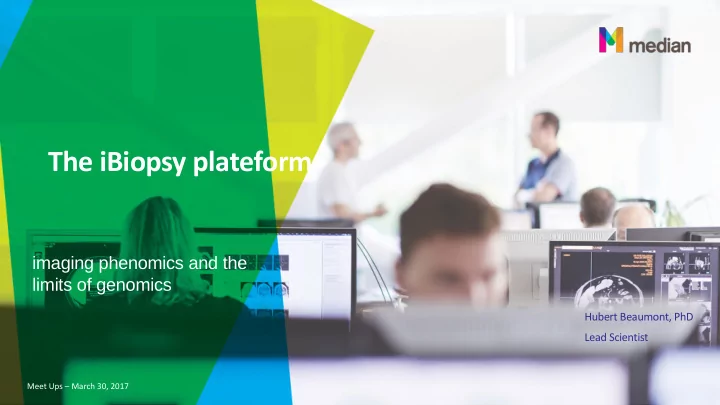

The iBiopsy plateform - imaging phenomics and the limits of genomics Hubert Beaumont, PhD Lead Scientist Meet Ups – March 30, 2017
Precision Medicine Problem Statement There is a need to identify which patients are likely to derive the most benefit from targeted therapies Biomarkers—especially predictive biomarkers—are crucial tools in the field of personalized medicine and health economics, in particular, as they enable definition of the populations of patients who are most likely to benefit from targeted therapies. Some groups report that current pharmacogenetic approaches are suboptimal . More-effective patient selection and treatment assessment is mandatory to improve the success rate of new therapies. Multiplex phenotype : Complex contribution of numerous genes, the epigenome and environmental factors.
The Genotype-Phenotype Relationship Genotype is not the only contributor to Phenotype
Limitations of Genomics to Precision Medicine Not the single Risk Predictor Most clinical traits are polygenic . Height is affected by more than 180 genes. The genome only contributes a fraction of the expressed trait . For height it less than 10%. Downstream modifying factors, the epigenome, the environment, have a significant contributing influence . Although partial risk prediction will be feasible and medically useful in some cases, there are likely to be fundamental limits on precise prediction due to the complex architecture of common traits, including common variants of tiny effect, rare variants that cannot be fully enumerated and complex epistatic interactions, as well as many non-genetic factors. Dr. Eric Lander : “Initial impact of the sequencing of the human genome”, Nature, 2011
New Paradigm Needed From Genome to Phenome Whole genome sequencing approaches can be suboptimal at assessing risk for most common diseases. Most disease risk factors are not purely genetic. Paradigm shift away from a genocentric to a phenocentric view, is what is really needed to improve our understanding of complex diseases and deliver targeted therapies. Focus may be on Phenotype not Genotype The phenotype is the expressed trait that physicians look for 5
Radiomics/Phenomics: State of the art A very active area Reproducibility generally not addressed Features N % Imaging method MRI 75 36% CT 40 19% PET 14 7% US 81 39% Study goal 182 56% Diagnosis/staging/outcome pred. Response 63 30% L. Alic et Al. “Quantification of Heterogeneity as a Biomarker in Tumor Imaging: A Systematic Review,” PLoS One, vol. 9, no. 10, p. e110300, 2014
Radiomics/Phenomics: A new start A reference study
Radiomics/Phenomics: A new start Material & Methods
Radiomics/Phenomics: A new start Results
Radiomics/Phenomics: A new start Conclusions “ Prognostic validation of radiomic signature ” “ Combining the radiomic signature with TNM staging showed a significant improvement ” “ We did not find a significant association between radiomic signature prediction and Human Papilloma Virus status. However, we found that the signature preserved its prognostic performance in the HPV negative group ” “ We found significant associations between the signature features and gene-expression patterns ”
Phenomics The Science of Biomarkers Phenomics is the large-scale collection and analysis of phenotypic data or biomarkers The phenotype is the expressed clinical trait The phenome is the catalog of phenotypic biomarkers Starting point should be the study of phenotypic variability Phenomics captures genomic, epigenetic, metabolic and environmental associations Phenotype may be more predictive than genotype Phenomics requires a big data , high throughput analytics approach
iBiopsy: from Imaging to Phenomics
Decoding the Image Step 1: Automated organ segmentation, ROI identification and multi-resolution tiling
Indexing the Phenotypes Step 2: Organizing individual phenotypes in clusters by similarity BOARD MEETING - WOBURN OFFICES - OCT. 6, 2016 - CONFIDENTIAL 14
Automated Biomarker Extraction Thousands of Biomarkers Extracted per Phenotype 15
Creation Of Phenotype Reference Database High Throughput Data Extraction & Indexing 16
Phenotype Search Engine Content-based phenotype retrieval in real-time from Cloud 17
Imaging Phenomics The New Paradigm BIG DATA ANALYTICS IMAGING End to end imaging platform for: Imaging Biomarkers correlate to: • Large scale data acquisition • Gene-expression • Massively parallel feature extraction • Disease biology • Biomarker computation • Patient status (TNM) • Predictive Analytics • Treatment outcome • Personalized medicine
Advantages of Imaging Biomarkers Non invasive methods Suited for heterogeneous tissues Analyzes the entire tumor at once Biomarkers can be quantified Imaging acquisition methods are standardized Available for routine clinical use Biomarker extraction can be automated Big data makes the analysis of millions of phenotypes feasible
The User Interface
The User Interface
Analytics
Used technologies
Value Proposition Target Applications Early detection of cancers and other chronic diseases (NASH) Predicting treatment response Predicting patient prognosis or outcome Selecting patients for clinical trials Identifying biological processes at individual level High throughput screening for development of targeted compounds
Requirements for Phenomics Phenomics requires a Big Data Computing Platform for large scale phenotypic data collection and analysis. High-dimensional imaging biomarker discovery and validation Tens of thousands of variables and feature combinations Millions of computations per image require high throughput architectures Supervised and unsupervised analysis using Big Data Analytics Tools High quality, fully indexed databases of phenotypic traits images and biomarkers.
Median iBiopsy Platform Highly differentiated based on proprietary technology & processes MEDIAN is uniquely positioned to offer a high-throughput, comprehensive, accurate, end-to-end image mapping and analysis platform for large scale extraction of imaging biomarkers and phenotypic signatures. iBiopsy is based on state-of-the-art “big-data” architecture highly optimized for automated phenotype indexing and analysis. Cloud Computing Platform in collaboration with Microsoft.
Recommend
More recommend